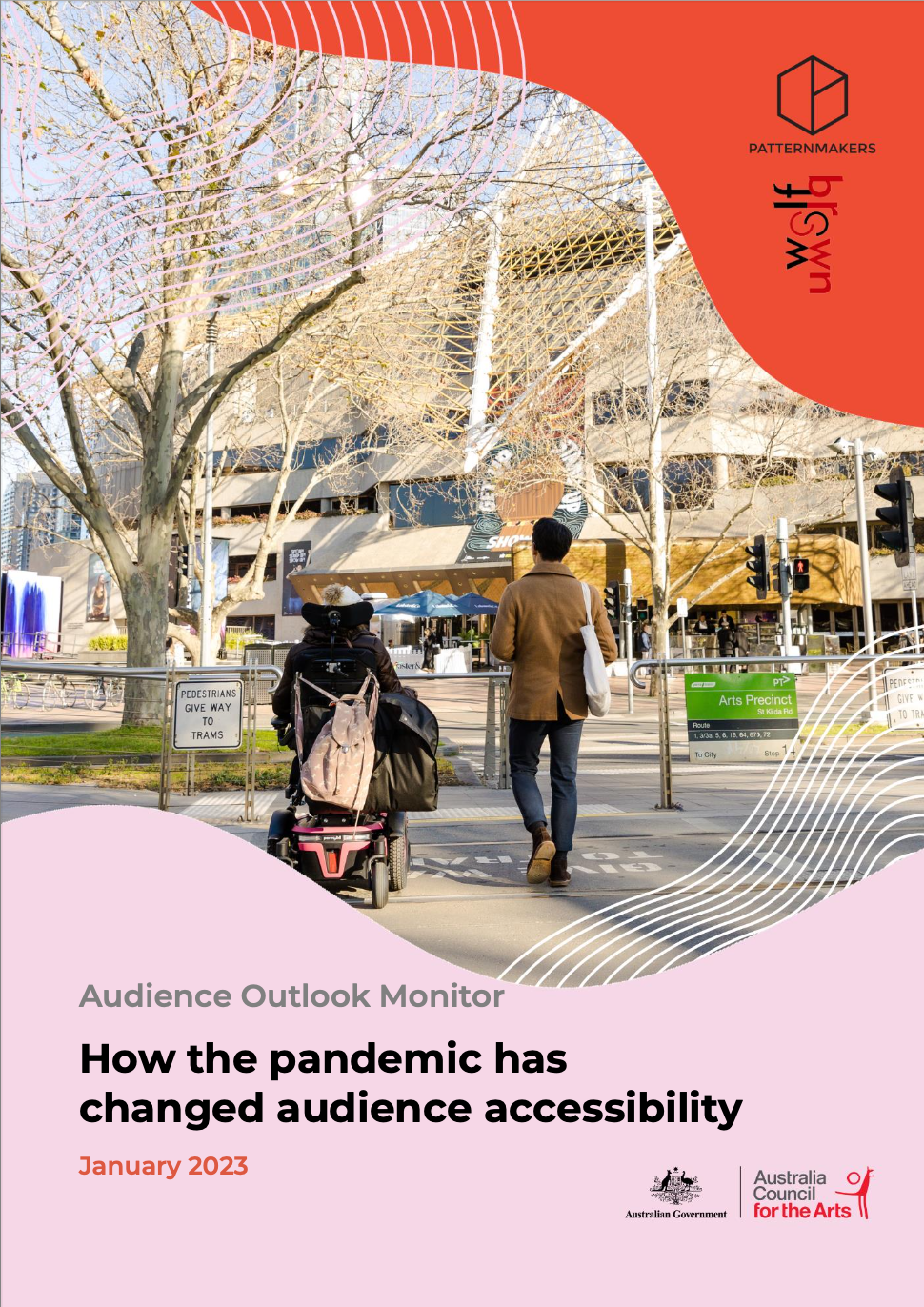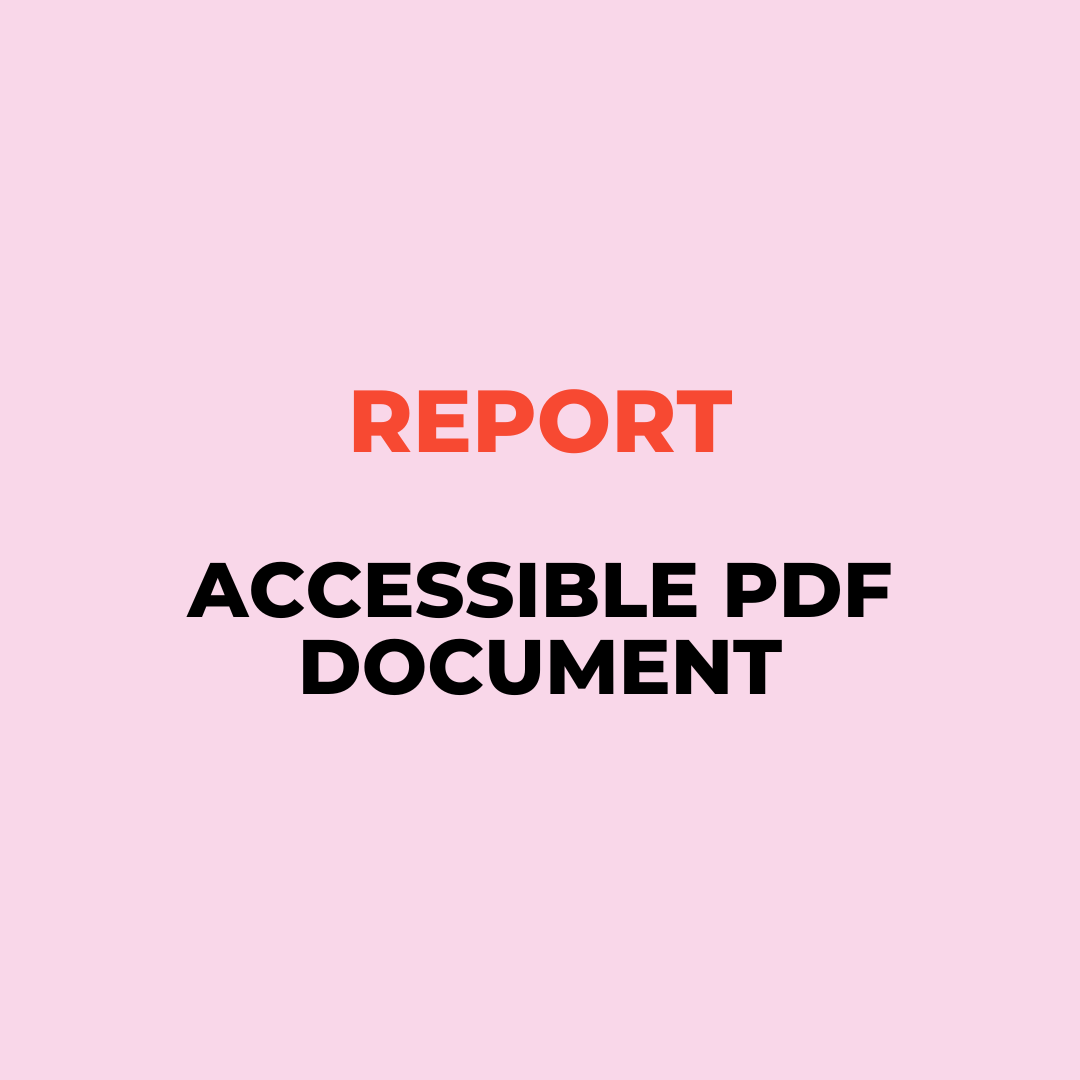How the pandemic has changed audience accessibility
Attendance by audiences with access needs is recovering – but at a slower rate than average
In our latest Audience Outlook Monitor publication, we take a look at the attendance insights and barriers for audiences affected by access issues, including the return of crowds, the cost of living crisis and the success and sustainability of digital events.
Click the images below to download a PDF of the full report and an infographic of the key facts:
The findings are also available in the following accessible versions:
Read on for the key insights:
Attendance levels among audiences with access needs have fluctuated during the pandemic. Data from October 2022 shows that 7 in 10 (69%) disabled audience members attended a cultural event recently – more than three times the level seen in July 2020 (19%). However, these attendance levels are increasing at a slower rate than average.
The fact that arts spaces, including museums, have been less busy has offered some disabled and immunocompromised audiences improved access to cultural activities at certain points in the pandemic.
The availability of digital events dramatically improved access for some segments. In October, 47% said they participated online recently, compared to 39% of those without access needs, though some note a dramatic reduction in the availability of online events.
Attendance has yet to return to pre-pandemic levels – and may take longer than audiences without access needs. 6 in 10 (58%) audiences with access needs are attending performing arts less than they used to, pre-pandemic, compared to 41% of audiences without access needs.
This report highlights insights from the Audience Outlook Monitor surveys, along with four case studies of audiences with access needs. They show that access needs continue to vary widely – and that more work is needed to address continuing and new barriers.
Audiences with access needs are changing their behaviour and require updated strategies
While in general disabled audiences are more likely to face barriers to attending cultural events, the pandemic has led to new and heightened access needs. 26% of audiences surveyed identify as being disabled (10%) or immuno-compromised themselves (10%), or close to someone who is (9%), showing the impact of these issues.
There are signs that more people may be experiencing access challenges due to factors such as long COVID, reduced energy levels and re-entry anxiety.
Audiences with access needs are twice as likely to say their scheduling preferences have changed in light of the pandemic . 1 in 3 (32%) say there has been a change in the time, day or location of events, compared to 17% of audiences without access needs.
Some audiences say that they’re now more likely to attend during the daytime and/or weekdays to avoid crowded times or places, minimise fatigue, and consider the availability of public transport when planning their attendance.
Financial pressures disproportionally affect audiences with access needs. The proportion citing financial reasons as a barrier to attendance is larger among audiences with access needs (49%), compared to those without (39%).
Although digital events can help to overcome barriers to live attendance, their availability is changing, and they are not for everyone. 75% of audiences with access needs see a role for digital events in their lives, but many are eager for opportunities to reconnect with the arts in-person, especially after times of isolation.
The pandemic has shown it’s possible to challenge the status quo to make the arts more accessible
In some senses, the pandemic made the needs and experiences of people with disability more visible. Collective harm minimisation strategies, like lockdowns, encouraged the public to consider the needs of immunocompromised individuals and those at risk of serious health outcomes from COVID-19.
There are signs that work by d/Deaf and disabled artists and disability activists is contributing to a greater cultural awareness of disability and organisational capacity for access. Deaf artist Sue Jo Wright suggests even the presence of Auslan Interpreters at daily press conferences during lockdowns helped bring more exposure to the d/Deaf community.
After being advocated for by people with disability for many years, the livestreaming of arts events became a central part of cultural life during lockdowns – although there’s still work to be done to find sustainable models for digital events.
Some people with disability will be limited in their ability to participate in public life while the virus continues to circulate, and the arts has an essential role to play in maintaining social connection and reflecting these experiences.
The pandemic showed us that it’s possible to reorganise existing social practices for the collective good, especially where accessibility is concerned. Vital conversations, led by people with disability, have taken place – and the lessons learned mean the sector is better-equipped to take action to ensure the arts are accessible and inclusive.
There is an opportunity to review and update Disability Action Plans to capitalise on what has been learned and explore new strategies.
This report also includes four case studies to augment data with lived experience
A series of structured qualitative interviews were undertaken with audience members who identify as d/Deaf or disabled. Hearing from people with lived experience of inaccessibility highlights some of the challenges and opportunities for the arts and culture sector.
Opportunities exist for improving access on-site, online and organisationally
Together, the Audience Outlook Monitor and case study research reveal some practical suggestions that are relevant at this time:
On-site
Provide as much information as possible, ahead of events, whether it’s about venue accessibility, COVID-safety measures or ticketing policies, or the performance or venue itself. Providing information up-front about what to expect will help individuals with access needs plan their attendance on-site.
Check whether all Front of House staff have received Disability Awareness Training, and/or appoint a dedicated roving staff member before, during and after live events to proactively offer support. As we return to in-person events, it’s important to recognise that encountering untrained staff can have an emotional toll for audiences with disability.
With the use of QR codes becoming commonplace during the pandemic, venues might think about using this technology to offer alternative options for ordering food and drink, audio descriptions or Auslan interpretation.
Restore and increase sensory-friendly options such as relaxed performances, noise-cancelling headphones and quiet spaces to ensure audiences with sensory needs are able to fully participate. Tactile experiences weren’t possible during some stages, but most audiences say it’s now time to offer these again.
Review seating options as attendance numbers increase. Find ways to make seating available in most spaces of the event or venue – such as foyers and queuing areas – as well as performance and exhibition spaces. In addition to audiences with mobility needs, 30% of audiences say they need seating to enjoy attending.
Online
Websites:
When welcoming disabled audiences back, look into having a dedicated accessibility page on your website, so that audiences with access needs can simply and easily find the information they need. This avoids placing the ‘burden of asking’ on audiences with access needs and demonstrates a commitment to inclusivity.
Digital productions:
Now that in-person events have returned to a regular schedule, continue investing in digital work that is sustainable for your organisation. The pandemic taught us that digital events play a vital role in accessibility and overcoming barriers to participating in cultural experiences – and many want them to continue.
Hybrid events are one option, but sometimes digital attendees can feel sidelined compared to in-person attendees. Consider digital-only events, or appointing a digital facilitator to ensure people tuning in from home are given the opportunity to engage with performers/speakers and ask questions during Q&A’s.
Marketing/communications:
Use inclusive language and accessible formats in digital advertising, communications and booking systems to let potential attendees know that an event or venue is accessible to all. This includes Plain English resources or Auslan interpretation, audio descriptions, image descriptions and alternative text.
Organisationally
As we look to the next chapter, the conversation about accessibility is evolving. Consider reviewing and updating your Disability Inclusion Action Plan to address the heightened needs of audiences with access requirements.
Incorporate accessibility early, for example when planning and decision-making. Add an accessibility line to your budget templates and develop a checklist for accessibility considerations when conducting important tasks like selecting venues, programming and commissioning works, advertising opportunities, launching major marketing campaigns and ticketing major events.
Involve disabled and immunocompromised people in the planning process of your major programs and projects. This can assist in fostering allyship and creating opportunities for people without access needs to collaborate with disabled and immunocompromised people on access strategies.
With cost of living pressures disproportionately affecting disabled audiences, explore revenue models that address financial barriers such as subsidised ticketing policies, accessibility funds supported through grants, donations or fundraising, or partnering with advocacy groups and support networks.
Further resources
Below is a list of additional resources, with guidance on improving accessibility for audiences.
Accessible Arts resources: https://aarts.net.au/arts-resources/
Arts Hub Artists Essentials Toolkit #9: Accessibility for your arts project: https://www.artshub.com.au/news/career-advice/accessibility-for-your-arts-project-artists-essentials-toolkit-9-2501288/
Melbourne Fringe, Producer’s Guide to Access: https://melbournefringe.com.au/wp-content/uploads/2022/08/Producers-Guide-to-Access-1.pdf
Morwenna Collett Consulting resources: https://www.morwennacollett.com/resources
National Endowment for the Arts, Design for Accessibility: A Cultural Administrator’s Handbook: https://www.arts.gov/about/publications/design-accessibility-cultural-administrators-handbook
Smithsonian Guide for Accessible Exhibition Design: https://www.sifacilities.si.edu/sites/default/files/Files/Accessibility/accessible-exhibition-design1.pdf
Use the dashboard to get results for your artform and region
Survey data from over 5,400 respondents has been uploaded to the dashboard, which now contains insights from 100,000 Australian participants.
You can use the dashboard to explore the findings by state/territory, artform and audience segment.
It’s freely available to access, just click the image below and use the login details provided on the dashboard page.
About the Audience Outlook Monitor
The Audience Outlook Monitor provides the results of a study that has tracked audience sentiment over the course of the COVID-19 pandemic.
Data was collected in six phases throughout 2020-2022. A new approach will be taken in 2023.
Government agencies across Australia are collaborating with research agencies Patternmakers (Sydney) and WolfBrown (USA) to produce this resource. The dashboard is freely accessible and designed to help artists and cultural organisations of all kinds to make the best possible decisions.
How to find out more
To receive new releases directly into your inbox, as soon as they are available, you can opt in to receive Audience Outlook Monitor news below.
Subscribers to our regular Culture Insight & Innovation Updates will need to update their preferences to receive all updates about the Audience Outlook Monitor. Just enter your email below and follow the instructions provided.
If you have a question, or an idea for using this data, please contact Patternmakers at info@thepatternmakers.com.au
Subscribe for updates
About the Author
Bianca Mulet
Senior Research Analyst
Delivery partners
Supporting partners
Past posts on this blog
- 2016 5
- 2017 8
- 2018 12
- 2019 11
- 2020 3
- 2021 7
- 2022 23
- 2023 21
- 2024 1
- About Patternmakers 35
- Accessibility 4
- Arts 73
- Audience development 79
- Beyond the Bio 8
- COVID-19 70
- Capacity building 3
- Career Advice 9
- Case Studies 2
- Coronavirus 2
- Culture 72
- Culture Panel 1
- Dance 3
- Data art 2
- Data culture 69
- Digital art 4
- Education 2
- Evaluation 75
- First Nations 3
- Indigenous 2
- Innovation 78
- Interviews 3
- Manifesto 1
- Opportunities 4
- Our services 4
- Performing Arts 5
- Postcode Analysis 1
- Privacy 6
- Project updates 25
- Publications 1
- Research 99
- Resources 6
- Strategic Planning 5
- Tandi Palmer Williams 7
- Theory of Creativity Podcast 1
- Thought leadership 16
- Tips & Tricks 13
- Toolkit 5
- Top 5 2
- Touring 3
- Trends 3























